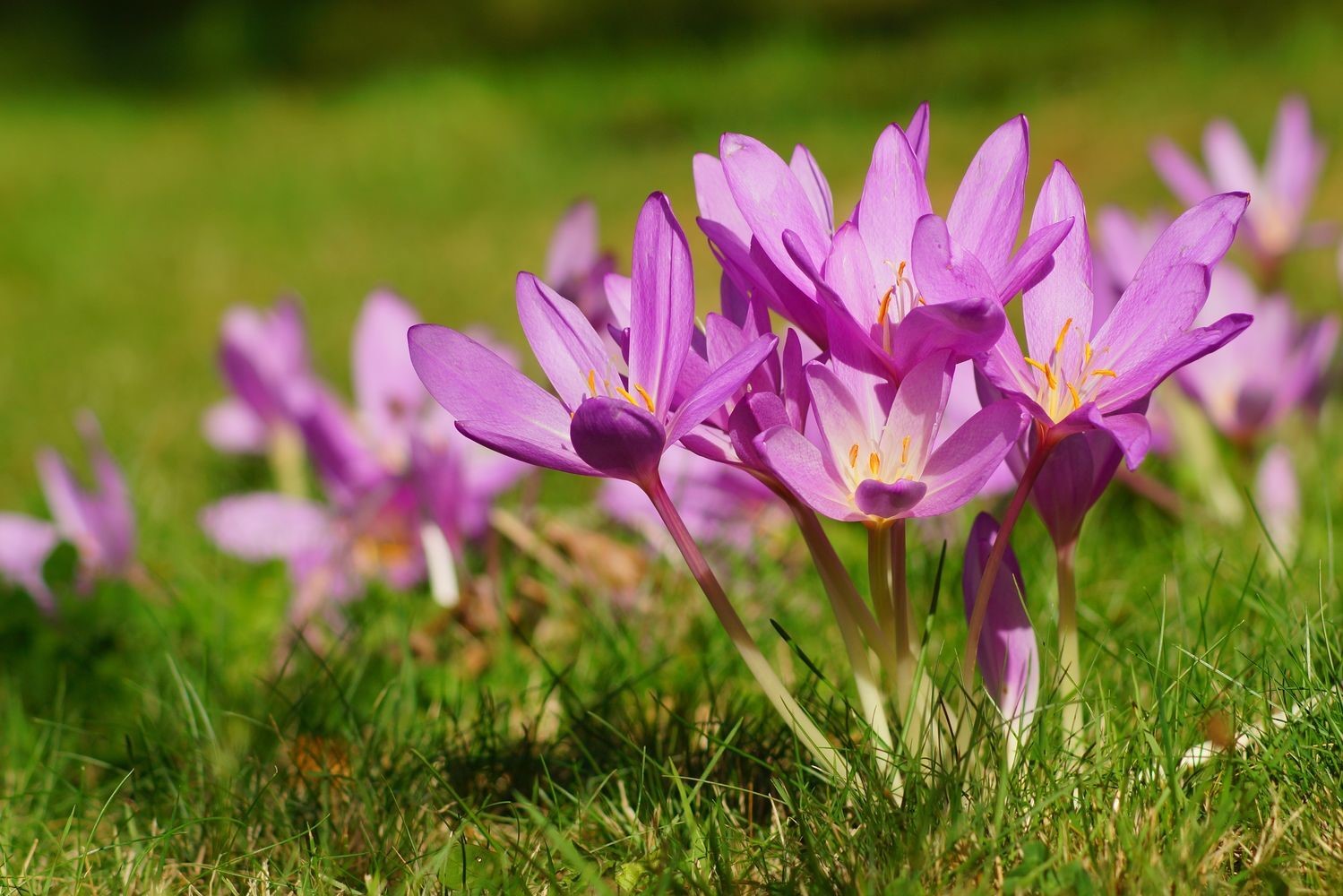
Autumn crocus, also known as Colchicum autumnale, is a stunning flowering plant that belongs to the family Liliaceae. This vibrant perennial is native to Europe and parts of North Africa, and it is renowned for its beautiful autumn blooms. While the name “crocus” may lead you to think of spring, these flowers actually grace us with their presence in the fall months, adding a touch of vibrant color to gardens and landscapes.
Aside from their visual appeal, autumn crocuses have fascinating characteristics that make them an intriguing subject of study. In this article, we will uncover 18 mind-blowing facts about autumn crocus. From their unique life cycle to their medicinal uses, these facts will shed light on the wonders of this delightful plant. So, let’s dive into the world of autumn crocus and explore the captivating facts that lie beneath their autumnal allure.
Key Takeaways:
- Autumn Crocuses are not true crocuses, blooming in the fall with toxic properties. They have a unique blooming pattern and cultural significance, making them a captivating addition to gardens.
- These vibrant flowers prefer well-draining soil, full sun to partial shade, and are deer-resistant. They symbolize love and fidelity, making them a meaningful gift for loved ones.
They are not really crocuses
Contrary to their name, the Autumn Crocus, also known as Colchicum autumnale, is not actually a crocus. It belongs to the Colchicaceae family, while traditional crocuses belong to the Iridaceae family.
They bloom in the fall
As the name suggests, Autumn Crocuses bloom during the fall season. Their vibrant pink or purple flowers emerge after summer and add a splash of color to gardens and landscapes.
They are toxic
Autumn Crocuses contain a toxic compound called colchicine. Ingesting any part of the plant can cause severe discomfort and poisoning symptoms. It is important to handle them with care, especially if there are children or pets around.
The flowers emerge before the leaves
One unique characteristic of Autumn Crocuses is that their flowers appear before their leaves. This unusual blooming pattern sets them apart from most other plants.
They are native to Europe and parts of Asia
Autumn Crocuses are native to Europe, specifically to regions such as the Mediterranean and the Balkans. They can also be found in parts of Asia, including Turkey, Iran, and Western China.
They have medicinal properties
Colchicine, the toxic compound found in Autumn Crocuses, has also been used for its medicinal properties. It has been used in the treatment of gout, a form of arthritis, and has shown potential in cancer research.
They are deer-resistant
Autumn Crocuses have a natural defense mechanism against deer. The toxic nature of the plant makes it unappealing to these animals, making them less likely to be consumed in gardens or natural habitats.
They have an interesting propagation method
Autumn Crocuses don’t propagate through seeds like many other plants. Instead, they produce small underground corms that serve as storage organs, allowing the plant to survive through the winter and sprout new growth in the following season.
They have cultural significance
Autumn Crocuses hold cultural significance in various regions. In Turkey, for example, the flowers are associated with the arrival of spring and are used as symbols of new beginnings and hope.
They prefer well-draining soil
Autumn Crocuses thrive in well-draining soil. It is important to ensure that the soil doesn’t become waterlogged, as excessive moisture can lead to root rot and hinder the growth of the plant.
They attract pollinators
The vibrant flowers of Autumn Crocuses attract pollinators such as bees and butterflies. These insects play a crucial role in the plant’s reproduction process by transferring pollen from one flower to another.
They have different varieties
Autumn Crocuses come in various cultivars, each with its own unique characteristics. Some popular varieties include ‘Waterlily,’ which has double flowers, and ‘Album,’ which features white blooms.
They have a long history of cultivation
The cultivation of Autumn Crocuses dates back centuries. They have been prized in gardens and were even mentioned in ancient works such as the writings of Theophrastus, a Greek philosopher and botanist.
They can naturalize in the right conditions
In suitable environments, Autumn Crocuses can naturalize and spread over time. With minimal care and the right growing conditions, they can form beautiful carpets of flowers, enhancing the beauty of any landscape.
They prefer full sun to partial shade
Autumn Crocuses thrive in areas with full sun to partial shade. These light conditions provide the necessary energy for the plant to grow and produce its stunning flowers.
They are drought-tolerant
Autumn Crocuses can withstand periods of drought. However, it is still important to provide some water during extended dry spells to ensure the plant remains healthy and continues to bloom.
They can be grown in containers
Autumn Crocuses can be successfully grown in containers and pots. This makes them a great choice for those with limited garden space or who want to add a touch of autumn beauty to their patios or balconies.
They symbolize love and fidelity
In the language of flowers, Autumn Crocuses symbolize love and fidelity. They can make a meaningful gift for a loved one or be used to convey heartfelt emotions on special occasions.
So there you have it, the 18 Mind-blowing Facts About Autumn Crocus. These beautiful flowers bring charm and magic to the fall season with their vibrant blooms and intriguing characteristics. Whether you admire them in gardens or cultivate them in your own space, Autumn Crocuses are sure to captivate your senses and leave you in awe of nature’s wonders.
Conclusion
In conclusion, the autumn crocus is a fascinating plant with a rich history and many intriguing characteristics. From its vibrant blooms that signal the arrival of fall, to its toxic properties that make it unique among its floral counterparts, there is much to discover about this stunning plant. Whether you are a gardening enthusiast or simply appreciate the beauty of nature, the autumn crocus is sure to captivate your attention.Remember, while the autumn crocus can add a touch of elegance to your garden, it is important to handle it with care due to its toxicity. If you plan to grow these plants, take precautions to keep them away from children and pets.So next time you spot the delicate blossoms of the autumn crocus, take a moment to admire its beauty and reflect on the incredible wonders that nature has to offer.
FAQs
1. Are autumn crocus flowers really poisonous?
Yes, they are. All parts of the autumn crocus contain a toxic compound called colchicine, which can cause severe symptoms if ingested.
2. Can I grow autumn crocus indoors?
Yes, you can grow autumn crocus indoors in pots. However, it’s important to keep them out of reach of children and pets due to their toxicity.
3. How do I propagate autumn crocus?
Autumn crocus can be propagated by dividing the bulbs in late summer or early spring. Simply dig up the bulbs and separate the smaller ones from the main bulb, then replant them at the desired location.
4. How long do autumn crocus flowers last?
The flowers of autumn crocus usually last for about two to three weeks, depending on the weather conditions and care provided.
5. Can I plant autumn crocus in containers?
Yes, autumn crocus can be successfully grown in containers. Choose a well-draining soil mix and place the container in a location that receives partial sunlight.
Autumn Crocus, with its vibrant blooms and intriguing folklore, captivates gardeners and nature enthusiasts alike. Beyond the 18 mind-blowing facts shared, there's even more to explore about this fascinating plant. Colchicum, a close relative of Autumn Crocus, holds its own set of unbelievable truths waiting to be discovered. So, if you're curious to learn more about these enchanting fall-blooming beauties, keep reading and uncover the secrets they hold.
Was this page helpful?
Our commitment to delivering trustworthy and engaging content is at the heart of what we do. Each fact on our site is contributed by real users like you, bringing a wealth of diverse insights and information. To ensure the highest standards of accuracy and reliability, our dedicated editors meticulously review each submission. This process guarantees that the facts we share are not only fascinating but also credible. Trust in our commitment to quality and authenticity as you explore and learn with us.


